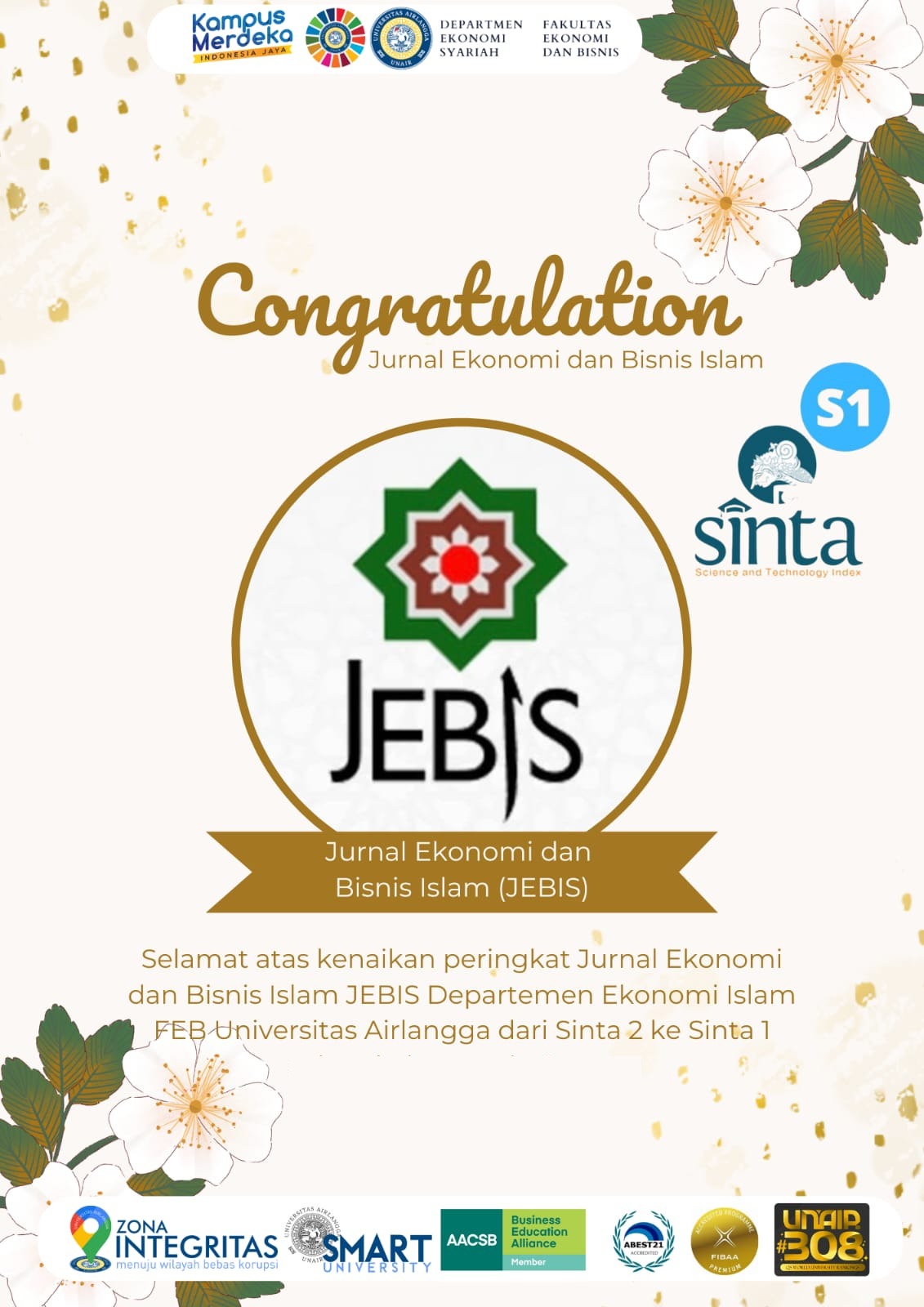ACCELERATION AND STRENGTHENING OF SHARIA FINANCIAL INCLUSION THROUGH MERGING SHARIA BANKING IN INDONESIA
Downloads
Islamic banking in Indonesia is slowly experiencing significant developments both in terms of number of assets and its financial performance. On the other hand, the market share was only able to grow by 6.18 percent with grow rate less than 5 percent. Therefore, one of the strategies to increase and accelerate the growth of Islamic banking is through a merger. The purpose of this study is to provide an overview of the potential development of Islamic banking after the merger as an effort to strengthen the inclusion and acceleration of Islamic finance in Indonesia. The method used is in the form of a systematic analysis review by collecting various secondary data and then conducting a quality assessment to obtain in-depth research objectives. The results found through content analysis indicate that the merger strategy provided added value to the banking industry through greater market expansion, increased cost efficiency, financial performance, and lowering prices, to meet the public need for sharia-based financial services. Through a merger strategy, Islamic banking is able to become a new pillar of national economic strength and encourage Indonesia to become the center of the world on Islamic finance.
Afdi, M., & Nasir, M. (2020). Strengthening Sharia Banking through Merger or Consolidation. Munich Personal RePEc Archive, 97964.
Ahdizia, K., Masyita, D., & Sutisna, S. (2018). Business Valuation of Islamic Banks in Merger Plan To Become An Indonesia's State-Owned Islamic Bank. Etikonomi, 17(2), 223–236. https://doi.org/10.15408/etk.v17i2.7238
Al-Hroot, Y. A., Al-Qudah, L. A., & Alkharabsha, F. I. (2020). The impact of horizontal mergers on the performance of the Jordanian banking sector. Journal of Asian Finance, Economics and Business, 7(7), 49–58. https://doi.org/10.13106/jafeb.2020.vol7.no7.049
Al-Sharkas, A. A., Hassan, M. K., & Lawrence, S. (2008). The impact of mergers and acquisitions on the efficiency of the US banking industry: Further evidence. Journal of Business Finance and Accounting, 35(1–2), 50–70. https://doi.org/10.1111/j.1468-5957.2007.02059.x
Alharbi, A. (2015). Development of the Islamic Banking System. Journal of Islamic Banking and Finance, 3(1), 12–25. https://doi.org/10.15640/jibf.v3n1a2
Ascarya, & Yumanita, D. (2005). Bank Syariah : Gambaran Umum (Issue 14). Pusat Pendidikan dan Studi Kebanksentralan.
Bank Indonesia. (2018). STRATEGI, KEBIJAKAN & PROGRAM PENGEMBANGAN EKONOMI DAN KEUANGAN SYARIAH. Bank Indonesia.
Berger, A. N., & Humphrey, D. B. (1992). Megamergers in Banking and the Use of Cost Efficiency as Antitrust Defense. The Antitrust Bulletin, 37(4), 541–600.
Brewer, E., Jackson, W. E., & Jagtiani, J. (2005). Impact of Independent Directors and the Regulatory Environment on Bank Merger Prices: Evidence from Takeover Activity in the 1990s. SSRN Electronic Journal, 2000(December), 1–31. https://doi.org/10.2139/ssrn.256990
Calomiris, C. ., & Karceski, J. (2000). Is the Bank Merger Wave of the 1990s Efficient? Lessons from Nine Case Studies. In Steven N. Kaplan. University of Chicago Press.
Carletti, E., Hartmann, P., & Onega, S. W. (2008). The economic impact of merger control legislation. ECONSTOR, 4, 28–34.
Carletti, E., Hartmann, P., & Ongena, S. (2007). The economic impact of merger control: what is special about banking? ECB Working Paper, 786.
Clarke, N., & Salleh, N. M. (2011). Emotions and their management during a merger in Brunei. Human Resource Development International, 14(3), 291–304. https://doi.org/10.1080/13678868.2011.585064
DeYoung, R. (2002). The Effects of Geographic Expansion on Bank Efficiency. Journal of Financial Services Research, 19(1), 163–84.
Egger, P., & Hahn, F. R. (2010). Endogenous bank mergers and their impact on banking performance. Some evidence from Austria. International Journal of Industrial Organization, 28(2), 155–166. https://doi.org/10.1016/j.ijindorg.2009.07.007
Elnahas, A. M., Hassan, M. K., & Ismail, G. M. (2017). Religion and Mergers and Acquisitions Contracting: The Case of Earnout Agreements. SSRN Electronic Journal. https://doi.org/10.2139/ssrn.2800794
Fahim, F., Wajidi, F. A., Abid, S., & Rehan, E. W. (2017). POTENTIAL OF ISLAMIC FINANCE IN GROWTH. International Journal of Economics, Commerce and Management, V(2), 403–435.
Focarelli, D., & Panetta, F. (2003). ARE MERGERS BENEFICIAL TO CONSUMERS? EVIDENCE FROM THE MARKET FOR BANK DEPOSITS. CEIS Tor Vergata RESEARCH PAPER SERIES, 4(10), 2–16.
Ghosh, A., & Jain, P. C. (2000). Financial leverage changes associated with corporate mergers. Journal of Corporate Finance, 6(4), 377–402. https://doi.org/http://dx.doi.org/10.1016/s0929- 1199(00)00007-9.
Goyal, K. A., & Joshi, V. (2011). Impact of Merger on Stress Level of Employees ( A Case Study of Erstwhile Bank of Rajasthan Ltd .). International Journal of Business Research and Management (IJBRM), 234–248.
Gupitasari, N., Setyowati, R., & Muhyidin. (2016). MEKANISME KONSOLIDASI BANK SYARIAH ANAK PERUSAHAAN BADAN USAHA MILIK NEGARA (BUMN) DARI PERSPEKTIF YURIDIS. DIPONEGORO LAW JOURNAL, 5(3), 1–22.
Hans Degryse, Masschelein, N., & Mitchell, J. W. (2004). SMEs and Bank Lending Relationships: the Impact of Mergers. Econstor, 46, 298–312.
Haynes, M., & Thompson, S. (1999). The productivity effects of bank mergers: Evidence. Journal of Banking & Finance, 23, 825–846.
Healy, P. M., Palepu, K. G., & Ruback, R. S. (1992). Does corporate performance improve after mergers? Journal of Financial Economics, 31(2), 135–175.
Hendriana, N. G. (2011). ANALISIS PERKEMBANGAN DAN PREDIKSI TINGKAT PERTUMBUHAN BANK SYARIAH DI INDONESIA. J. Res Islamic Econ, 3(1), 23–38.
Hidayat, S. E. (2019). Kajian Konversi Merger Holding dan Pembentukan Bank BUMN Syariah. Komite Nasional Keuangan Syariah.
Islamic Finance Country Index. (2020). Islamic Finance Country Index-IFCI 2019. Global Islamic Finance Report 2019, 49–79.
Ismariyah. (2007). Merger Bank dalam Tinjauan Hukum Islam (Kasus Merger Bank Mandiri). Jurnal Hukum Islam, 4(2), 1.
J.Gitman, L., & Zutter, C. J. (2012). Principles of Managerial Finance. 13th Edition. Prentice Hall.
Jayaratne, J., & Strahan, P. . (1997). The Benefits of Branching Deregulation. Economic Policy Review, 3(4), 13–19.
K.A, G., & Joshi Vijay. (2011). Mergers in Banking Industry of India:Some emerging issues. Asian Journal of Business and Management Sciences, 1(2), 157–165.
Karceski, J., Ongena, S., & Smith, D. C. (2005). The impact of bank consolidation on commercial borrower welfare. Journal of Finance, 60(4), 2043–2082. https://doi.org/10.1111/j.1540-6261.2005.00787.x
Kemal, M. U. (2011). Post-Merger Profitability : A Case of Royal Bank of Scotland ( RBS ). International Journal of Business and Social Science, 2(5), 157–162.
Kementrian Pernecanaan dan Pembangunan Nasional. (2018). Masterplan Ekonomi Syariah Indonesia 2019-2024 Hasil Kajian Analisis Ekonomi Syariah di Indonesia. Badan Perencanaan Pembangunan Nasiona.
Komite Nasional Keuangan Syariah. (2020). TREND KONVERSI KE BANK SYARIAH: Tingkatkan Efisiensi dan Produktivitas Bisnis. Insight Buletin Ekonomi Syariah, 9, 1–11.
Long, P. H. (2015). Merger and Acquisitions in the Czech Banking Sector-Impact of Bank Mergers on the Efficiency of Banks. Journal of Advanced Management Science, 3(2), 86–92. https://doi.org/10.12720/joams.3.2.86-92
Marimin, A., & Romdhoni, A. H. (2017). Perkembangan Bank Syariah Di Indonesia. Jurnal Ilmiah Ekonomi Islam, 1(02), 75–87. https://doi.org/10.29040/jiei.v1i02.30
Miftah, K., & Wibowo, H. (2017). Merger and Industrial Acceleration: Study at Indonesian Islamic Banking Industry. Signifikan: Jurnal Ilmu Ekonomi, 6(1), 29–48. https://doi.org/10.15408/sjie.v6i1.4728
Moelong, L. J. (2007). Metodologi Penelitian Kualitatif. Remaja Rosdakarya Offset.
Montoriol, & Garriga, J. (2008). Bank Mergers and Lending Relationships. ECB Working Paper, 3(34), 392–412.
Nasution. (2003). Pengertian Kualitatif: Dasar-dasar dan Aplikasi. Yayasan Asih Asah.
Nizar, M. A., & Nasir, M. (2016). Akselerasi dan Inklusivitas Sektor Keuangan : Jalan Menuju Kesejahteraan Rakyat. In Naga Media.
Otoritas Jasa Keuangan. (2019a). Laporan Perkembangan Keuangan Syariah Indonesia. In Otoritas Jasa Keuangan.
Otoritas Jasa Keuangan. (2019b). Statistik Perbankan Syariah 2020. Journal of Chemical Information and Modeling, 53(9), 1689–1699.
Pana, E., Park, J., & Query, T. (2010). The impact of bank mergers on liquidity creation. Journal of Risk Management in Financial Institutions, 4(1), 74–96.
Pradipta, H., & Zaharias, B. (2016). Estimate of Merger Impact and Acquisition To Banking Ef- Acquisition. Jurnal Ekonomi Dan Pembangunan, 24(2), 85–95.
Prihartono, A. (2018). PENGATURAN PENGGABUNGAN USAHA (MERGER) BANK SEBAGAI UPAYA PENINGKATAN KESEHATAN BANK DI INDONESIA DALAM PEMBANGUNAN HUKUM EKONOMI NASIONAL. AKTUALITA, 1(1), 1–15.
Sari, M. D., Bahari, Z., & Hamat, Z. (2013). PERKEMBANGAN PERBANKAN SYARIAH DI INDONESIA : SUATU TINJAUAN. JURNAL APLIKASI BISNIS, 3(2), 120–138.
Sherman, H. D., & Rupert, T. J. (2006). Do bank mergers have hidden or foregone value? Realized and unrealized operating synergies in one bank merger. European Journal of Operational Research, 168(1), 253–268. https://doi.org/10.1016/j.ejor.2004.05.002
Sufian, F. (2006). the Efficiency of Islamic Banking Industry: a Non-Parametric Analysis With Non-Discretionary Input Variable. Islamic Economic Studies, 14(1), 54–87.
Suhendro, D. (2018). Pertumbuhan Dan Perkembangan Perbankan Syariah Di Indonesia. Human Falah, 5(2), 211–227.
Syukron, A. (2014). DINAMIKA PERKEMBANGAN PERBANKAN SYARIAH DI INDONESIA. Economic: Jurnal Ekonomi Dan Hukum Islam, 3(2), 28–53.
Vallascas, F., & Hagendorff, J. (2011). The impact of European bank mergers on bidder default risk. Journal of Banking and Finance, 35(4), 902–915. https://doi.org/10.1016/j.jbankfin.2010.09.001
Yumanita, D., & Ascarya. (2005). Bank Syariah: Gambaran Umum. In Bank Indonesia (Vol. 14, Issue 14).
Zuhair, M. K. (2008). AKSELERASI PERTUMBUHAN BANK SYARIAH DI INDONESIA. Millah, 8(1), 2008.
Copyright (c) 2021 JEBIS (Jurnal Ekonomi dan Bisnis Islam)

This work is licensed under a Creative Commons Attribution-NonCommercial-ShareAlike 4.0 International License.
- Every manuscript submitted to JEBIS must obey to the policy and terms set by Journal of Economics and Business Islamic.
- Publication rights on the contents of manuscript published by JEBIS is owned by JEBIS under consent and approval by the corresponding author(s).
- Full text of electronic publication of manuscripts can be accessed free if used for the purpose of education and research according to copyright regulation.
- Share ” copy and redistribute the material in any medium or format
- Adapt ” remix, transform, and build upon the material
- You must give appropriate credit, provide a link to the license, and indicate if changes were made. You may do so in any reasonable manner, but not in any way that suggests the licensor endorses you or your use.
- You may not use the material for commercial purposes.
- If you remix, transform, or build upon the material, you must distribute your contributions under the same license as the original.
Creative Commons Attribution-NonCommercial-ShareAlike 4.0 International License.





.png)














